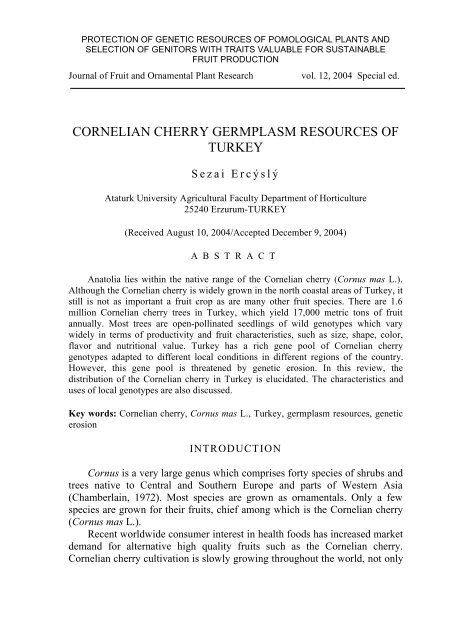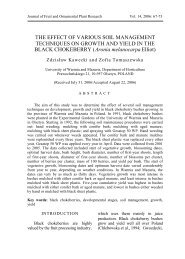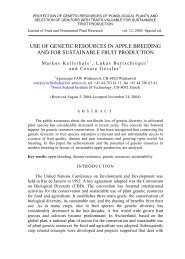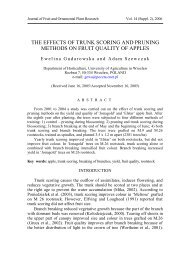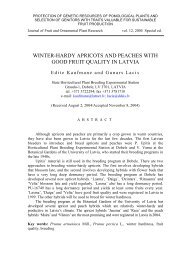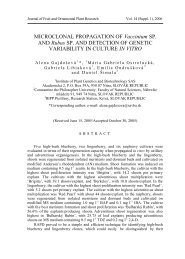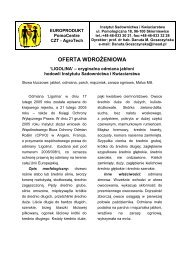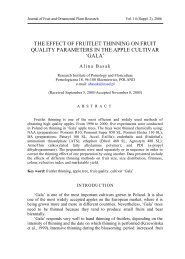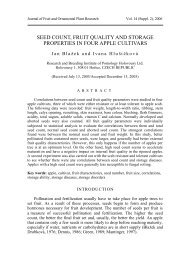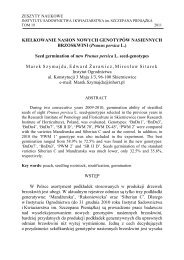Cornelian cherry germplasm resources of Turkey
Cornelian cherry germplasm resources of Turkey
Cornelian cherry germplasm resources of Turkey
You also want an ePaper? Increase the reach of your titles
YUMPU automatically turns print PDFs into web optimized ePapers that Google loves.
PROTECTION OF GENETIC RESOURCES OF POMOLOGICAL PLANTS AND<br />
SELECTION OF GENITORS WITH TRAITS VALUABLE FOR SUSTAINABLE<br />
FRUIT PRODUCTION<br />
Journal <strong>of</strong> Fruit and Ornamental Plant Research<br />
vol. 12, 2004 Special ed.<br />
CORNELIAN CHERRY GERMPLASM RESOURCES OF<br />
TURKEY<br />
Sezai Ercýslý<br />
Ataturk University Agricultural Faculty Department <strong>of</strong> Horticulture<br />
25240 ErzurumTURKEY<br />
(Received August 10, 2004/Accepted December 9, 2004)<br />
ABSTRACT<br />
Anatolia lies within the native range <strong>of</strong> the <strong>Cornelian</strong> <strong>cherry</strong> (Cornus mas L.).<br />
Although the <strong>Cornelian</strong> <strong>cherry</strong> is widely grown in the north coastal areas <strong>of</strong> <strong>Turkey</strong>, it<br />
still is not as important a fruit crop as are many other fruit species. There are 1.6<br />
million <strong>Cornelian</strong> <strong>cherry</strong> trees in <strong>Turkey</strong>, which yield 17,000 metric tons <strong>of</strong> fruit<br />
annually. Most trees are openpollinated seedlings <strong>of</strong> wild genotypes which vary<br />
widely in terms <strong>of</strong> productivity and fruit characteristics, such as size, shape, color,<br />
flavor and nutritional value. <strong>Turkey</strong> has a rich gene pool <strong>of</strong> <strong>Cornelian</strong> <strong>cherry</strong><br />
genotypes adapted to different local conditions in different regions <strong>of</strong> the country.<br />
However, this gene pool is threatened by genetic erosion. In this review, the<br />
distribution <strong>of</strong> the <strong>Cornelian</strong> <strong>cherry</strong> in <strong>Turkey</strong> is elucidated. The characteristics and<br />
uses <strong>of</strong> local genotypes are also discussed.<br />
Key words: <strong>Cornelian</strong> <strong>cherry</strong>, Cornus mas L., <strong>Turkey</strong>, <strong>germplasm</strong> <strong>resources</strong>, genetic<br />
erosion<br />
INTRODUCTION<br />
Cornus is a very large genus which comprises forty species <strong>of</strong> shrubs and<br />
trees native to Central and Southern Europe and parts <strong>of</strong> Western Asia<br />
(Chamberlain, 1972). Most species are grown as ornamentals. Only a few<br />
species are grown for their fruits, chief among which is the <strong>Cornelian</strong> <strong>cherry</strong><br />
(Cornus mas L.).<br />
Recent worldwide consumer interest in health foods has increased market<br />
demand for alternative high quality fruits such as the <strong>Cornelian</strong> <strong>cherry</strong>.<br />
<strong>Cornelian</strong> <strong>cherry</strong> cultivation is slowly growing throughout the world, not only
S. Ercýslý<br />
because it bears delicious and nutritious fruits, but also because it is an<br />
attractive ornamental plant and is among the first to blossom in spring<br />
(Szendi, 2000).<br />
Research on the nutritional value <strong>of</strong> the <strong>Cornelian</strong> <strong>cherry</strong> has focused on<br />
nutrients which play a role in preventing deficiency diseases such as scurvy.<br />
Fresh <strong>Cornelian</strong> <strong>cherry</strong> fruits contain twice as much vitamin C as oranges.<br />
The <strong>Cornelian</strong> <strong>cherry</strong> is also widely used in pharmotherapeutics. The fruits<br />
and leaves have antidiarrhetic properties, and may also be used as an<br />
astringent or febrifuge. The fruits have been used in traditional medicine.<br />
<strong>Cornelian</strong> <strong>cherry</strong> fruits are know to increase appetite (Baytop, 1984; Chiej,<br />
1984).<br />
<strong>Turkey</strong> has great agricultural potential because each region <strong>of</strong> the country<br />
can support the cultivation <strong>of</strong> different kinds <strong>of</strong> crops. Each region <strong>of</strong> <strong>Turkey</strong> has<br />
its own unique flora because soil and climate conditions vary widely throughout<br />
the country. This rich and diverse flora is an important source <strong>of</strong> plants which<br />
provide food, wood and pharmaceutical raw materials (Ercisli, 2004).<br />
<strong>Turkey</strong> has a long history <strong>of</strong> <strong>Cornelian</strong> <strong>cherry</strong> cultivation and a wealth <strong>of</strong><br />
<strong>Cornelian</strong> <strong>cherry</strong> genotypes. The <strong>Cornelian</strong> <strong>cherry</strong> is a shrub or small tree<br />
which can reach seven to eight meters in height. It bears tart purple, yellow or<br />
red fruits the size <strong>of</strong> olives (Kayacik, 1966; Yaltirik, 1981). The <strong>Cornelian</strong><br />
<strong>cherry</strong> is becoming a more popular crop because <strong>of</strong> recent advances in<br />
breeding superior varieties which have an attractive color, low tannin content,<br />
and high sugar content (Karadeniz, 2000).<br />
In <strong>Turkey</strong>, 97% <strong>of</strong> the <strong>Cornelian</strong> <strong>cherry</strong> crop is harvested from open<br />
pollinated seedlings <strong>of</strong> wild genotypes. The fruits are eaten fresh, dried whole,<br />
pickled like olives, or used to produce jam, jelly, marmalade, syrup or wine<br />
(Karadeniz, 2000).<br />
Because the plants are open pollinated, they vary widely in terms <strong>of</strong><br />
productivity and fruit characteristics, such as size, shape, color, flavor and<br />
nutritional value. Thorough evaluation <strong>of</strong> the genetic <strong>resources</strong> <strong>of</strong> the native<br />
genotypes is essential for selecting those genotypes most useful for future<br />
breeding programs designed to introduce traits such as hardiness and disease<br />
resistance from wild genotypes into cultivated varieties.<br />
The aim <strong>of</strong> this review is to provide information on the status <strong>of</strong> the<br />
genetic <strong>resources</strong> <strong>of</strong> the <strong>Cornelian</strong> <strong>cherry</strong> in <strong>Turkey</strong>, on the distribution <strong>of</strong> the<br />
<strong>Cornelian</strong> <strong>cherry</strong> in different regions <strong>of</strong> the country, and on the characteristics<br />
and uses <strong>of</strong> genotypes from different provinces.<br />
MATERIAL AND METHODS<br />
This review is based on previous studies conducted in different regions <strong>of</strong><br />
<strong>Turkey</strong> (Chamberlain, 1972; Eris et al., 1992; Karadeniz, 1995; Karadeniz,<br />
2000; Karadeniz et al., 2001; Pirlak et al., 2003).<br />
88<br />
J. Fruit Ornam. Plant Res. Special ed. vol. 12, 2004: 8792
<strong>Cornelian</strong> <strong>cherry</strong> <strong>germplasm</strong> <strong>resources</strong> <strong>of</strong> <strong>Turkey</strong><br />
RESULTS AND DISCUSSION<br />
Distribution <strong>of</strong> cornelian cherries in <strong>Turkey</strong><br />
The dominant Cornus species found in <strong>Turkey</strong> is the <strong>Cornelian</strong> <strong>cherry</strong>,<br />
known in Turkish as kizilcik. In <strong>Turkey</strong>, the <strong>Cornelian</strong> <strong>cherry</strong> grows as a small<br />
tree seven to eight meters in height and 25 to 45 cm in diameter (Yaltirik,<br />
1981). The vast majority <strong>of</strong> the <strong>Cornelian</strong> <strong>cherry</strong> genetic <strong>resources</strong> in <strong>Turkey</strong><br />
is made up <strong>of</strong> natural stands (Ercisli, 2004). Only a small portion is made up<br />
<strong>of</strong> cultivated plantations. Natural stands <strong>of</strong> the <strong>Cornelian</strong> <strong>cherry</strong> are found in<br />
approximately one third <strong>of</strong> the country, especial northern coastal regions (Tab.<br />
1). The Ministry <strong>of</strong> Agriculture (Anonymous, 2001) reports that the<br />
<strong>Cornelian</strong> <strong>cherry</strong> grows in over thirty provinces, including the provinces <strong>of</strong><br />
Amasya, Artvin, Balikesir, Bartin, Bolu, Bursa, Canakkale, Cankiri, Duzce,<br />
Erzurum, Giresun, Gumushane, Kastamonu, Kutahya, Malatya, Sinop,<br />
Samsun, Trabzon, Tokat, Yalova and Zonguldak (Fig. 1).<br />
Aegean Sea<br />
Canakkale<br />
Balikesir<br />
Black Sea<br />
Sinop<br />
Zonguldak Kastamonu Samsun<br />
Giresun<br />
Sakarya<br />
Artvin<br />
Karabuk<br />
Trabzon<br />
Ordu Gumushane<br />
Yalova Duzce Cankiri Tokat<br />
Bursa<br />
Erzurum<br />
Kutahya<br />
Mediterranean Sea<br />
Malatya<br />
N<br />
TURKEY<br />
0 100 200 300 km<br />
Figure 1. Distribution <strong>of</strong> the <strong>Cornelian</strong> <strong>cherry</strong> (Cornus mas L.) in <strong>Turkey</strong><br />
Table 1. Occurrence and population size <strong>of</strong> the <strong>Cornelian</strong> <strong>cherry</strong> (Cornus mas L.) in<br />
the nine regions <strong>of</strong> <strong>Turkey</strong><br />
Central North South East West Northwest Northeast Southwest Southeast<br />
X XX X X X XX XX X x<br />
XX – very abundant, X – abundant, x – rare<br />
Pomological studies<br />
In <strong>Turkey</strong>, the cornelian <strong>cherry</strong> has been propagated from seed for centuries.<br />
This has resulted in considerable genetic variability. About 97% <strong>of</strong> the trees are<br />
J. Fruit Ornam. Plant Res. Special ed. vol. 12, 2004: 8792 89
S. Ercýslý<br />
open pollinated seedlings <strong>of</strong> wild varieties. Only 3% <strong>of</strong> cultivated trees are<br />
propagated by grafting, mostly in the provinces <strong>of</strong> Bursa, Malatya and Yalova.<br />
Seedling populations in different regions <strong>of</strong> <strong>Turkey</strong> are very diverse and may<br />
prove to be sources <strong>of</strong> valuable donors for future breeding programs.<br />
<strong>Cornelian</strong> <strong>cherry</strong> breeding programs have been established in different<br />
regions <strong>of</strong> <strong>Turkey</strong> since the 1990s. Some promising selections were released in<br />
1993. Fortunately, pests and diseases are rarely serious problems with the<br />
heterogeneous seedling populations that occur in <strong>Turkey</strong>. The main goals <strong>of</strong> these<br />
breeding programs are to improve productivity and fruit characteristics, such as<br />
size, shape, color, flavor and nutritional value (Karadeniz, 1995).<br />
Table 2. Selected fruit properties <strong>of</strong> <strong>Cornelian</strong> <strong>cherry</strong> genotyes from <strong>Turkey</strong><br />
Location<br />
Konya<br />
Trabzon<br />
Zonguldak<br />
Malatya<br />
Bursa<br />
Giresun<br />
Coruh<br />
Fruit<br />
weight<br />
[g]<br />
Fruit<br />
lenght<br />
[mm]<br />
Fruit<br />
width<br />
[mm]<br />
3.65<br />
4.57<br />
1.31<br />
2.88<br />
2.28<br />
4.07<br />
1.02<br />
4.07<br />
1.67<br />
6.53<br />
1.66<br />
3.22<br />
2.90<br />
5.20<br />
18.31<br />
21.23<br />
14.32<br />
22.35<br />
13.87<br />
16.42<br />
14.09<br />
23.51<br />
16.10<br />
27.77<br />
15.30<br />
19.30<br />
17.00<br />
25.01<br />
13.79<br />
16.10<br />
11.29<br />
14.57<br />
17.97<br />
23.51<br />
9.46<br />
16.42<br />
10.70<br />
18.00<br />
11.62<br />
14.92<br />
13.10<br />
19.20<br />
Flesh/stone<br />
ratio<br />
TSS<br />
[%]<br />
Vitamin<br />
C<br />
[mg/100<br />
ml]<br />
Altitude<br />
[m]<br />
– – – 1200<br />
3.206.90 8.013.5 – 300<br />
5.007.25<br />
2.79<br />
7.2<br />
2.057.42<br />
2.977.38<br />
6.009.40<br />
12.1<br />
16.9<br />
11.7<br />
22.5<br />
11.7<br />
22.5<br />
10.0<br />
18.5<br />
11.5<br />
16.8<br />
– 300<br />
49122 1100<br />
Refernces<br />
Turkoglu et al.,<br />
1999<br />
Karadeniz et al.,<br />
2001<br />
Yalcinkaya and<br />
Eti, 2000<br />
Yalcinkaya et<br />
al., 1999<br />
– 1100 Eris et al.,1992<br />
– 300 Karadeniz, 1995<br />
36106 900<br />
Pirlak et al.,<br />
2003<br />
Selected fruit properties <strong>of</strong> <strong>Cornelian</strong> <strong>cherry</strong> genotypes from different<br />
provinces <strong>of</strong> <strong>Turkey</strong> are presented in Table 2. Fruit weight ranged from 1.0 to 6.5<br />
grams, fruit length from 1.3 to 2.8 cm, fruit width from 0.9 to 2.3 cm, flesh to stone<br />
ratio from 2.0 to 9.4, soluble solids content from 8.0 to 22.5%, and vitamin C<br />
content from 36 to 122 mg/100 g. The trees were found growing anywhere from<br />
300 to 1200 meters above sea level.<br />
In spite <strong>of</strong> recent progress in the breeding programs, consumers are still not<br />
completely satisfied with fruit quality. Future breeding programs need to take into<br />
account the requirements <strong>of</strong> producers, distributors and consumers.<br />
Genetic Erosion<br />
Important sources <strong>of</strong> <strong>Cornelian</strong> <strong>cherry</strong> <strong>germplasm</strong> are being lost because<br />
stands are being cut to produce walking sticks, especially in northwestern<br />
<strong>Turkey</strong>. In other regions <strong>of</strong> the country, deforestation also threatens to<br />
eradicate <strong>Cornelian</strong> <strong>cherry</strong> populations. Special locations have to be<br />
demarcated to protect the genetic resource <strong>of</strong> native <strong>Cornelian</strong> <strong>cherry</strong> trees.<br />
90<br />
J. Fruit Ornam. Plant Res. Special ed. vol. 12, 2004: 8792
<strong>Cornelian</strong> <strong>cherry</strong> <strong>germplasm</strong> <strong>resources</strong> <strong>of</strong> <strong>Turkey</strong><br />
It is not known how the various <strong>Cornelian</strong> <strong>cherry</strong> genotypes in <strong>Turkey</strong> are<br />
related to each other. Genotypes have to be collected from the field and assembled<br />
in suitable locations where they can be systematically evaluated. It would also be<br />
useful to have a centralized location for evaluation, selection, breeding, propagation<br />
and distribution. Efforts are underway to establish a centralized collection at the<br />
Ataturk Central Horticultural Research Institute in Yalova.<br />
The collection and evaluation <strong>of</strong> <strong>Cornelian</strong> <strong>cherry</strong> genotypes should be<br />
given very high priority because many genotypes are in danger <strong>of</strong> being lost.<br />
These genotypes are indispensable for increasing the commercial potential <strong>of</strong><br />
cultivated <strong>Cornelian</strong> <strong>cherry</strong> varieties. The first step in the conservation<br />
process is to identify threatened populations and develop effective strategies<br />
to protect them. The best longterm strategy is to introduce selected productive<br />
genotypes into state and private nurseries and orchards.<br />
Genetic <strong>resources</strong> provide a sustainable source <strong>of</strong> genetic raw material for<br />
improving cultivated varieties. They contain unique naturally selected coadapted<br />
gene constellations which determine adaptability and productivity.<br />
Therefore, the conservation <strong>of</strong> genetic <strong>resources</strong> is <strong>of</strong> paramount importance<br />
for reliable and sustainable food production for future generations.<br />
REFERENCES<br />
Anonymous 2001. Agricultural Structure (Production, Price, Value). State<br />
Institute <strong>of</strong> Statistics Prime Ministry Republic <strong>of</strong> <strong>Turkey</strong>. 600 p.<br />
Baytop T. 1984. Turkiyede Bitkilerle Tedavi. I.U.ECZACILIK FAK. YAY. 40: 298299.<br />
Chamberlain D.F. 1972. Flora <strong>of</strong> <strong>Turkey</strong> and East Aegean Islands. In: P.H.<br />
Davis (ed.). Edinburgh University Press, Edinburgh, pp. 54041.<br />
Chiej R. 1984. Encyclopaedia <strong>of</strong> Medicinal Plants. MacDonald Company, 356 p.<br />
Ercisli S. 2004. A short review <strong>of</strong> the fruit <strong>germplasm</strong> <strong>resources</strong> <strong>of</strong><br />
<strong>Turkey</strong>. GEN. RES. CROP EVOL. 51: 419435.<br />
Eris A. Soylu A. Barut E. Dalkılıç Z. 1992: The selection studies<br />
on cornelian <strong>cherry</strong> cultivars grown in Bursa Region. Proc 1 st Nat. Hort. Con. 20<br />
24 September 1992, pp. 499502.<br />
Karadeniz T. 1995. A study on the selection <strong>of</strong> native cornelian cherries grown<br />
in Gorele district in <strong>Turkey</strong>. BAHCE 24(12): 3644.<br />
Karadeniz T. 2000. Selection <strong>of</strong> native cornelian cherries grown in <strong>Turkey</strong>. J.<br />
AMER. POMOL. SOC. 56(3): 164167.<br />
Karadeniz T. Kalkisim O. Baltaci C. 2001. The investigation on<br />
pomological characteristics <strong>of</strong> cornelian <strong>cherry</strong> (Cornus mas L.) grown in Trabzon.<br />
Proc. 1 st Nat. Stone Fruits Symp., 2528 September 2001, Yalova, pp. 307311.<br />
Kayacik H. 1966. Orman ve park ağaçlarının özel sistematiği, IU ORMAN FAK.<br />
YAY 106/3: 164169.<br />
Pirlak L. Guleryuz M. Bolat I. 2003. Promising cornelian cherries<br />
(Cornus mas L.) from the Northeastern Anatolia region <strong>of</strong> <strong>Turkey</strong>. J. AMER.<br />
POMOL. SOC. 57(1): 1418.<br />
J. Fruit Ornam. Plant Res. Special ed. vol. 12, 2004: 8792 91
S. Ercýslý<br />
Szendi A. 2000. Large scale in vitro propagation <strong>of</strong> highly nutritive cornelian<br />
<strong>cherry</strong> (Cornus mas L.) elite genotypes. www. Biotechnology.hu/conference/project/doc/bio023.doc.<br />
Turkoglu N. Gazioglu R.I. Kor M. 1999. Investigations on selection<br />
<strong>of</strong> cornelian <strong>cherry</strong> grown in Derebucak (Konya). Proc III Nat. Hort. Con. 1417<br />
September, Ankara, pp. 768771.<br />
Yalcinkaya E. Kaska N. Guloglu U. Karabat S. 1999.<br />
Pomological traits <strong>of</strong> selected cornelian cherries in Malatya region. ). Proc. III<br />
Nat. Hort. Con. 1417 September, Ankara, pp. 7681.<br />
Yaltirik F. 1981. Dendroloji 1, IU ORMAN FAK. YAY. 299:7273.<br />
ZASOBY GENOWE DERENIA WŁAŚCIWEGO<br />
W TURCJI<br />
Sezai Ercýslý<br />
STRESZCZENIE<br />
Anatolia jest jednym z rejonów występowania derenia właściwego (Cornus mas<br />
L.) w stanowiskach naturalnych. Dereń jest uprawiany na rozległych przybrzeżnych<br />
terenach w północnej części Turcji, jednak nie zyskał on większego znaczenia<br />
podobnie jak wiele innych gatunków roślin o jadalnych owocach. Szacuje się, że<br />
w Turcji rośnie 1,6 mln drzew derenia, z których rocznie uzyskuje się około 17 tys.<br />
ton owoców. Większość drzew jest siewkami lokalnych typów derenia. Dlatego ich<br />
owoce różnią się znacznie wielkością, kształtem, kolorem i innymi cechami. Państwo<br />
utrzymuje bogate zasoby genowe derenia w różnych regionach Turcji, ale istnieje<br />
zagrożenie, że ulegną one erozji genetycznej. Wraz ze znaczącym wzrostem populacji<br />
należy zabezpieczyć istniejące zasoby derenia właściwego w Turcji. W pracy<br />
przybliżono rozmieszczenie derenia (Cornus mas L.) w poszczególnych prowincjach<br />
Turcji oraz przedstawiono jego charakterystykę i sposób wykorzystania.<br />
Słowa kluczowe: dereń właściwy, Cornus mas L., Turcja, zasoby genowe, erozja<br />
genetyczna<br />
92<br />
J. Fruit Ornam. Plant Res. Special ed. vol. 12, 2004: 8792


